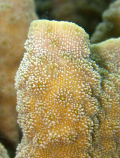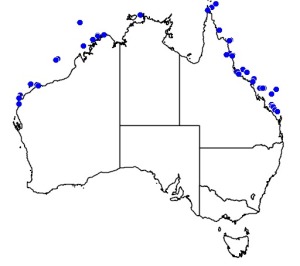
©Andy Lewis: Large colony of Echinopora lamellosa in shallow water at the lagoon entrance, showing a convoluted laminar growth form
Colours
Distinguishing features
A species that forms tiered layers, foliacious whorls, and tubular columns, to more than 5m diameter. Corallites are plocoid and conspicuous, and relatively widely spaced on the granulated coenosteum. Colonies are pale gray-brown to dark brown, often with green calices. Distinguish from the closely related E. pacificus by the smaller, more widely spaced corallites.
Size
- Size data has not been obtained.
Synonyms
Distribution
Distribution and habitat preferences
Shallow lagoonal and back reef areas.
Can be found in most habitats around Lizard Island.
Behaviour
This species is a hermaphroditic broadcast spawner, with oocytes and spermaries found on the same mesentaries within the polyp.
E. lamellosa has been found to contain a number of biologically active seconday metabolites with anti-bacterial activity. These compounds are more usually found in plants, and have not generally been isolated from scleractinian corals. Their role in the biology of coral is unknown.
In a study in Palau, this species was shown to orientate the growth planes of its laminae to best capture available light when growing in a low-light environment.
Web resources
References
- Baird, A.H., J.R. Guest and B.L. Willis (2009). Systematic and biogeographical patterns in the reproductive biology of scleractinian corals, Annual Review of Ecology, Evolution and Systematics, 40: 551-571.
- Baird, A.H. and P.A. Marshall (2000). Bleaching of corals on the Great Barrier Reef: differential susceptibilities among taxa, Coral Reefs, 19: 155-163.
- Berumen, M.L. (2000). Influence of diet and habitat on the condition of butterflyfish, M.Sc. thesis, James Cook University. LIRS catalog number 719.
- View all references











